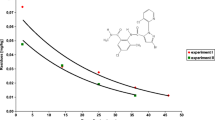Abstract
Imidacloprid was sprayed on mango cv. Dashehari at 0.3 mL L−1 of water during pre-bloom stage with 6–8 cm panicle size (first week of March) to control hopper and carbosulfan was sprayed at 2.0 mL L−1 of water in the trees of mango hybrid (H-1000) during fruit development stage (first week of May) to control leaf webber. Residues of both the insecticides were analysed in peel, pulp and fruit at different stages of fruit development and maturity. The initial residues of imidacloprid, after 30 days of spraying, were 1.21, 0.56 and 1.77 mg kg−1 in peel, pulp and whole fruit, respectively. The residues persisted in peel for 60 days and in pulp for 50 days and dissipated with a half-life of 38 days. Mature Dashehari fruits at harvest (after 85 days of spraying) were free from imidacloprid residues. Carbosulfan in mango peel dissipated from 5.30 mg kg−1 (after 1 h of spraying) to 0.05 mg kg−1 at the time of harvest (after 45 days of spraying). Carbosulfan residue in pulp was very low (0.08 mg kg−1) after 1 h of spraying, which increased gradually to 0.90 mg kg−1 after 10 days and finally came down to 0.04 mg kg−1 after 26 days of spraying. The insecticide residue was not detected in the pulp at the time of harvest. The residues persisted in pulp for 26 days and in peel for 45 days and degraded with a half-life of 7 days. The dissipation of both imidacloprid and carbosulfan followed first order rate kinetics in whole fruit (peel + pulp). Therefore, the safe pre-harvest intervals were suggested to be 55 days for imidacloprid and 46 days for carbosulfan before consumption of mango fruits after spraying of these insecticides.

Similar content being viewed by others
References
Anonymous (2010) http://www.cishlko.org/Technologies/MangoHopper_advisory.pdf. Accessed 10 Aug 2011
Arora PK, Jyot G, Singh B, Battu RS, Singh B, Aulakh PS (2009) Persistence of imidacloprid on grape leaves, grape berries and soil. Bull Environ Contam Toxicol 82:239–242
Banerjee K, Oulkar DP, Patil SB, Jadhav MR, Dasgupta S, Patil SH, Bal S, Adsule PG (2009) Multiresidue determination and uncertainty analysis of 87 pesticides in mango by liquid chromatography – tandem mass spectrometry. J Agric Food Chem 57:4068–4078
Bhattacherjee AK, Pandey BK, Prakash Om (2009) Persistence and dissipation of carbendazim residues in mango fruits after pre- and post-harvest applications. J Food Sci Technol 46:347–349
Dubey JK, Sharma ID, Patyal SK, Gupta D (2006) Translocation and persistence of imidacloprid in apple fruits. Pestic Res J 18:82–84
Gajbhiye VT, Agnihotri NP (1999) HPLC method for analysis of imidacloprid. In: Agnihotri NP, Walia SC, Gajbhiye VT (eds) Green pesticides, crop protection and safety evaluation. Society of Pesticide Science, India, New Delhi, pp 176–180
Hoskins ML (1961) Mathematical treatment of loss of pesticide residues. FAO Plant Prot Bull 9:163–169
Mohapatra S, Deepa M, Jagadish HK (2011) Behavior of beta cyfluthrin and imidacloprid in/on mango (Mangifera indica L.). Bull Environ Contam Toxicol 87:202–207
Mukherjee I, Gupta S, Kulshrestha A, Pant S, Singh A, Kumar A, Gajbhiye VT, Dikshit AK, Kulshrestha G (2007) Simultaneous estimation of aldicarb, carbofuran and carbaryl in water by HPLC. Pestic Res J 19:128–130
Rajeswaran J, Santharam G, Chandrasekaran S, Jayakumar R, Kuttalam S (2004) Persistence of carbosulfan in water at different pH. Pestic Res J 16:78–79
Rajeswaran J, Santharam G, Chandrasekaran S, Jayakumar R, Kuttalam S (2005) Persistence of carbosulfan in black, red and alluvial soils. Pestic Res J 17:71–73
Samanta A, Ghosh A, Hembram TK, Patra S, Somchowdhury AK (2009) Efficacy of insecticides against mango hoppers and fruit yield. Annu Plant Prot Sci 17:225–229
Sharma KK (2007) Pesticide residue analysis manual. Directorate of information and publications of agriculture. Indian Council of Agricultural Research, New Delhi, pp 94–98
Singh SB, Mukherjee I, Maisnam J, Kumar P, Gopal M, Kulshrestha G (2008) Determination of pesticide residues in IPM and non-IPM samples of mango (Mangifera indica). J Environ Sci Health B 43:300–306
Soler C, Hamilton B, Furey A, James KJ, Mańes J, Pico Y (2007) Liquid chromatography quadruple time-of-flight mass spectrometry analysis of carbosulfan, carbofuran, 3-hydroxycarbofuran, and other metabolites in food. Anal Chem 79:1492–1501
Sucheta RK, Khokhar KS (1996) Studies on the chemical control of sucking pests infesting okra. Annals Biol (Ludhiana) 12:104–109
Verghese A (2000) Effect of imidacloprid, lambda cyhalothrin and azadirachtin on the mango hopper, Idioscopus niveosparsus (Leth.) (Homoptera : cicadellidae). Acta Hort 509:733–736
Wu Q, Chang Q, Wu C, Rao H, Zeng X, Wang C, Wang Z (2010) Ultrasound-assisted surfactantϜ–enhanced emulsification microextraction for the determination of carbamate pesticides in water samples by high performance liquid chromatography. J Chromatogr A 1217:1773–1778
Author information
Authors and Affiliations
Corresponding author
Rights and permissions
About this article
Cite this article
Bhattacherjee, A.K. Persistence Behavior of Imidacloprid and Carbosulfan in Mango (Mangifera indica L.). Bull Environ Contam Toxicol 90, 233–237 (2013). https://doi.org/10.1007/s00128-012-0902-6
Received:
Accepted:
Published:
Issue Date:
DOI: https://doi.org/10.1007/s00128-012-0902-6




